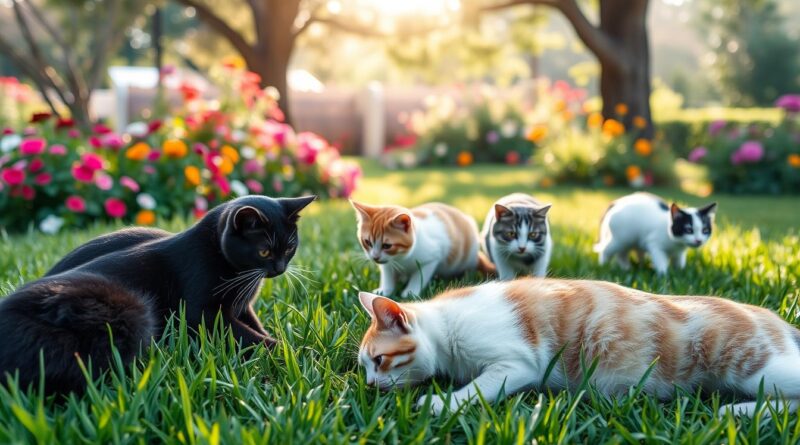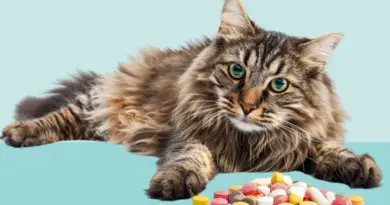Why Do Cats Eat Grass?
Cats have always fascinated us with their unique behaviors. One interesting thing they do is eat grass. We wonder why they do this. Is it a health issue or a natural instinct from their past?
There are many reasons why cats eat grass. Knowing these can help us understand their dietary habits better. We’ll look into why they like grass, their evolutionary history, and if it’s a natural behavior or a sign of a disorder.
Key Takeaways
- Cats eat grass for many reasons, like to help their digestion, get rid of hairballs, and get extra nutrients.
- Eating grass is a natural behavior for cats, coming from their past as meat-eaters.
- Most cats eating grass is okay, but too much might mean they’re sick or have a disorder.
- Offering safe plants like catnip or wheatgrass can meet their need to eat plants.
- Knowing why cats eat grass helps us manage this behavior better.
Unveiling the Mysterious Allure of Cats Eating Grass
As obligate carnivores, cats’ dietary preferences have long fascinated us. Why do cats eat grass, despite being meat-eaters? Exploring this behavior can reveal much about cats’ unique dietary preferences and evolutionary origins of plant foraging.
Understanding the Unique Dietary Preferences of Felines
Cats are obligate carnivores, needing animal proteins for survival. Yet, they also eat plants like grass. This shows there might be health or instinctual reasons behind it.
Exploring the Evolutionary Origins of Plant Foraging Behavior
- One theory is that grass gives felines nutrients like fiber and vitamins not found in meat.
- Grass consumption might also help with digestion and getting rid of hairballs, a common cat problem.
- The evolutionary origins of this behavior come from wild felids. They ate grass for nutrition or to fix digestive issues.
Understanding cats’ complex diet can give us insights into their evolutionary origins of plant foraging behavior. It shows how these obligate carnivores have adapted to their environments.
“Cats are a unique species that have evolved to meet their nutritional needs in a variety of ways, including the occasional consumption of plant matter.”
Cats Eating Grass: A Natural Instinct or a Pica Disorder?
Cats are curious, and eating grass is a common sight. Many wonder if it’s a natural act or a sign of a pica disorder. This question puzzles both pet owners and vets.
Cat grass ingestion is seen as a feline pica. This is when animals crave non-food items. Yet, many believe it’s a natural behavior for cats, linked to their past.
Some think cats eat grass to help with digestion or to get rid of hairballs. It might also be a way to get nutrients. On the other hand, pica disorder in cats could be linked to health issues, stress, or not getting enough nutrients.
“While grass-eating can be a natural behavior for cats, excessive or compulsive consumption may indicate a deeper issue that requires veterinary attention.”
It’s important for pet owners to understand this behavior. Knowing the difference between a natural act and a disorder helps them care for their cats better.
The Purr-fect Blend: Obligate Carnivores and Grass Consumption
Cats are obligate carnivores, needing animal proteins for nutrition. Many cats love to eat grass, which puzzles their owners. They wonder if grass is good for their pets.
Decoding the Nutritional Benefits of Grass for Feline Health
Grass might seem odd for cats, but it has benefits. It’s a good source of fiber, helping with digestion and preventing hairballs. Grass also has minerals and vitamins that can boost a cat’s health.
Some think cats eat grass to throw up. This helps them get rid of fur or bones. It’s a natural way to keep their digestive system healthy.
“Grass consumption is a natural behavior in cats, and it can provide them with important nutritional and digestive benefits.”
Grass eating might seem odd for cats, but it’s interesting. Knowing the benefits of grass helps pet owners meet their cats’ needs better.
Feline Dietary Habits: Unraveling the Reasons Behind Grass Ingestion
Cats eating grass is a mystery to many. It seems odd, but there are good reasons for it. Grass helps with digestion and can ease hairballs, making it a key part of a cat’s diet.
From Digestive Aid to Hairball Relief: The Multi-Purpose Role of Grass
Grass helps cats digest better. It acts like a natural laxative, pushing out hair and other stuff. This is great for cats that groom a lot, as it prevents hairballs.
Grass also helps with hairball relief. Its rough texture helps get rid of extra hair. This is good for cats, as hairballs can be harmful.
But, why do cats eat grass? It’s not just about digestion and hairballs. Stress or a lack of nutrients can also play a part. Sometimes, eating too much grass can mean there’s a health issue, like pica, that needs a vet’s help.
“Grass consumption in cats is a natural behavior that can serve multiple purposes, from aiding digestion to providing relief from hairballs. Understanding the multifaceted role of grass in a cat’s diet is key to ensuring their overall well-being.”
Knowing why cats eat grass helps us take better care of them. It ensures they stay healthy and happy.
Cats Eating Grass: A Sign of Illness or a Harmless Quirk?
Seeing your cat eat grass can be puzzling and worrying. It makes you wonder if it’s a sign of illness or just a quirky habit. Knowing why cats eat grass can help you figure out when it’s a problem and when it’s okay.
Usually, cats eating grass isn’t a big deal. Cats are meant to eat meat, not plants. But sometimes, they might eat grass to help with digestion or to get rid of hairballs. It could also just be because they’re curious.
But, sometimes, eating grass can mean there’s a health issue. If your cat is vomiting, has diarrhea, or isn’t eating, it could be a sign of illness. If you notice these signs, it’s best to talk to a vet to check if everything is okay.
In summary, while cat health and grass eating can be normal, it’s important to watch for any changes. By understanding why cats eat grass and getting help when needed, you can keep your cat happy and healthy.
The Grass is Greener: Providing Safe and Healthy Plant Options for Your Cat
We want our cats to have safe and healthy plants to eat. Growing catnip and wheatgrass indoors is a great way to do this. It lets them enjoy their natural urge to eat grass without danger.
Cultivating a Cat-Friendly Garden or Growing Catnip and Wheatgrass Indoors
Creating a green space for your cat is fun and rewarding. You can plant safe and healthy plant options for cats like:
- Catnip (Nepeta cataria): Cats love catnip, and it’s good for them too.
- Wheatgrass (Triticum aestivum): Wheatgrass is full of vitamins and minerals, making it a great choice.
- Oat grass (Avena sativa): Oat grass is another healthy option for cats.
- Cat mint (Nepeta cataria): Similar to catnip, cat mint is also a hit with cats.
Want to grow catnip and wheatgrass indoors? It’s easy. Just give your cat a special pot with good soil and enough sunlight.
“Providing your cat with safe and healthy plant options is a great way to cater to their natural instincts while keeping them safe and happy.”
Adding these safe and healthy plant options for cats to your home or garden is a smart move. It makes your space cat-friendly and lets your cat enjoy grass safely.
Feline Foraging Frenzy: Managing and Discouraging Excessive Grass Consumption
Cats are naturally curious, and eating grass can be a worry for owners. A little grass is okay, but too much can cause stomach problems or worse. We need to find a way to stop our cats from eating too much grass.
One good idea is to give your cat a cat-safe indoor grass patch. This lets them forage safely and keeps their grass eating in check. You can also try pet-friendly plants like catnip or wheatgrass. These plants might distract them from eating outdoor grass.
If your cat still eats too much grass, find out why. Stress, boredom, or a bad diet might be the reasons. Fixing these problems with more play, a better diet, and a happy home can help.
Preventing grass eating is better than treating it. Give your cat safe and fun things to do instead. This way, you can keep them healthy and stop them from eating too much grass.
“The key to managing excessive grass consumption in cats is understanding their natural instincts and providing appropriate, safe alternatives to satisfy their foraging needs.”
- Make a special indoor grass area for your cat to play and eat.
- Try pet-friendly plants like catnip or wheatgrass to distract them from outdoor grass.
- Fix any problems like stress or boredom that make them eat too much grass.
- Make sure your cat eats a balanced and healthy diet.
- Watch how much grass your cat eats and talk to your vet if it’s a problem.
With these steps, you can stop your cat from eating too much grass. This will help them stay healthy and happy.
Cats Eating Grass: A Cross-Cultural Phenomenon
Cats eating grass is a common sight worldwide. This behavior is seen in gardens from Europe to North America. It fascinates pet owners and researchers everywhere.
How people view cats eating grass varies by culture. In some places, it’s seen as normal. In others, it’s thought to be a health issue or a behavioral problem. This shows how complex our relationship with cats can be.
“Cats eating grass is a phenomenon that transcends geographical and cultural boundaries, reminding us of the enduring mysteries and intricacies of the animal kingdom.”
Looking at cats eating grass in different cultures helps us understand them better. It shows their unique dietary needs and how they’ve adapted over time. This appreciation deepens our connection with cats and their natural world.
In places like Japan, the UK, and the US, seeing a cat eat grass is common. It highlights the strong bond between humans and their cats. It’s a reminder of the special connection we share with our feline friends.
Conclusion: Embracing the Quirky and Fascinating World of Feline Dietary Habits
Cats eating grass is a complex issue, tied to their evolution. It helps with digestion and satisfies a natural urge. This behavior is key to their lives. Understanding why cats eat grass helps us see it as a natural part of their behavior.
The study of cats’ eating habits is captivating. It reveals how their plant-eating habits evolved and the health perks of eating grass. By learning about this, we can better appreciate our cats’ unique needs.
Watching your cat eat grass is a normal part of their life. You can offer safe plants or even a cat garden. This way, you meet their foraging needs while keeping them healthy. By embracing their quirks, we strengthen our bond with them and improve their life.
FAQ
Why do cats eat grass?
Cats, being obligate carnivores, naturally eat grass for several reasons. It aids digestion and helps with hairballs. It also provides nutrients missing in their meat-based diet.
Is it normal for cats to eat grass?
Yes, it’s normal for cats to eat grass. It’s an instinctive behavior. But, it could also be a sign of health issues or pica in some cases.
What are the potential benefits of cats eating grass?
Grass eating can benefit cats in many ways. It aids digestion and helps expel hairballs. It also provides nutrients and can induce vomiting to remove indigestible materials.
When should I be concerned about my cat’s grass-eating behavior?
While grass eating is normal, excessive or sudden changes are a concern. If your cat vomits often, has diarrhea, or loses weight, see a vet. They can check for health issues.
How can I provide safe and healthy plant options for my cat?
To meet your cat’s plant-eating instinct, grow cat-safe herbs or grasses indoors. This provides a safe alternative to outdoor grass, which may have chemicals or pests.
What are some effective ways to manage or discourage excessive grass consumption in cats?
To manage excessive grass eating, offer alternative scratching posts and toys. Make sure their diet is balanced. If it’s severe, see a vet to find the cause.




